» Home
» About
» Membership
» Journal
» Sparoza Garden
» Branches
» MGS Forum
» Seed Exchange
» Donations
» MGS Excursions
» Information
» Members' Gardens
» Book Reviews
» News & Views
» Contact
» Search
|
The MGS Garden at Sparoza
An introduction to the garden
The Mediterranean Garden No 45 carried a number of articles about the MGS garden at Sparoza, some of which are reprinted in full here as an introduction to newcomers to the garden:
Sparoza: Derek's Garden
by Sally Razelou, Custodian of the garden and first President of the Mediterranean Garden Society
The Path on the Hill, Sparoza
by Jennifer Gay, Garden Assistant from October 1999 to Jan 2001
The Nursery at Sparoza
by Caroline Harbouri, fifth President and Editor of The Mediterranean Garden
A Day at the Nursery
A photo reportage by Frosso Vassiliades

The garden in April photographed by visitors from the Vienna Botanic Garden
Sparoza: Derek’s garden
by Sally Razelou
from The Mediterranean Garden No 45 July 2006
During 1994 and 1995 when the MGS was in its infancy, Derek Toms came over to Sparoza two mornings each week to work in the garden. In April 1994 he began work on what he called ‘the wild garden’. It has also been termed ‘the native garden’, but to those who knew him it has always been known as ‘Derek’s garden’. The site of this garden is a piece of sloping ground between the terraces and the pools. Measuring approximately 20 metres by 16 metres, it slopes unevenly to a circular flat basin forming a small ‘amphitheatre’ over the septic tank. The drop is roughly two metres on the southern side and one and a half metres on the northern side.
In the centre of the flat circular area Jacky Tyrwhitt had planted a Cupressus. Conical in shape, it has smooth branches, some peeling bark clinging to their undersides, and a straight trunk with peeling bark that when freshly peeled exposes a beautiful smooth red wood which fades to a reddish-brown. The canopy of this tree now overlaps the circle of ground beneath it. Its most remarkable feature is its scented foliage – a really heavenly scent is emitted when the tiny scale-like leaves are caressed. I have not yet been established its name. Derek laid out a pathway leading down to the level area below the cypress and up again. Eleven steps and landings take us down and eight steps and landings bring us up on the pool side where the slope is less. The steps vary between 10cm and 18cm in height. The landings are between 40cm and 150cm long. He collected the stones by wheelbarrow from the hillside and set them into the dry and stony ground: an arduous task on the rough hillside under the Greek sun. Not a stone has moved from it moorings in the earth in the 12 years that have elapsed since then – a tribute to Derek’s skill and the standard of perfection he set in all he undertook. On either side of the pathway, by levelling and banking up with stones he created small terraces of various sizes and shapes for planting.
Over the years planting of many species has taken place. There have been disappointments. Globularia alypum, creeping thymes, Onosma species and Lithodora species have given up the ghost. Different species of Cistus have been planted but by the end of May they are desiccated and messy-looking with a lot of die-back in each bush. Successful plants such as Ruta graveolens and Ballota acetabulosa are invasive and overcome their weaker neighbours. Origanum onites and Euphorbia acanthothamnos do well, however, as does the Mandragora officinarum introduced from the island of Syros. Geophytes and rhizomatous plants are very rewarding. The following are present: Cyclamen graecum, Crocus goulimyi, C. niveus, C. cartwrightianus, Tulipa saxatilis, Gagea arvensis, G. graeca, Merendera attica, Ornithogalum umbellatum, O. narbonense, O. arabicum, Urginea maritima, Muscari commutatum, M. comosum, Scilla autumnalis, Allium neapolitanum, A. roseum, A. subhirsutum, A. sphaerocephalon, Iris unguicularis, I. pumila ssp. attica, Hermodactylus tuberosus, Sternbergia lutea, S. sicula, Asphodelus fistulosus, Fritillaria graeca, Narcissus papyraceus, N. serotinus.
After the rains, whenever they come in the autumn, many annuals germinate. Cerinthe retorta and Lamium moschatum are the first to do so, along with many other wild plants. By March, with the Cerinthe and Lamium in flower, joined by Tordylium apulum, Reseda alba, Tragopogon porrifolius and finally Papaver rhoeas and Delphinium staphisagria and many others, the garden is out of control but looks wonderful. It is hard to find the right balance in this garden; even though we weed and cull many of these beautiful wild flowers, new perennials planted in the autumn are swamped and deprived of light and air.
A Pinus halepensis shades the bottom S.E. corner of the garden next to the compost pits. Under it a Limoniastrum monopetalum, Ptilostemon chamaepeuce and Convolvulus oleifolius compete for space. These three shrubs all manage without irrigation and are in flower at the same time at the end of May. A very special perennial Verbascum of great beauty seems to be doing well. I collected cuttings while staying in Turkey with Megan and Derek Toms in 2001. It has the most lovely, almost white foliage due to the hairs on the simple, ovate, grey leaves. Another plant from the same area to be treasured is a green-leaved salvia with a potent, pungent scent and lovely form. I have not yet identified either of these plants, which are surviving outside their own habitat (at 800 metres on a S.W. peninsula of the Turkish mainland). George Sfikas brought us seed of Antirrhinum siculum, an endemic of Cephalonia, in 2004. A fine, elegant plant planted as a seedling in Derek’s garden flowered this April with its pale yellow spires; I shall collect the seed and pass it on to any member who wishes to grow it.
When Caroline Harbouri left her lovely old house and garden in Kifissia last year she gave to the garden at Sparoza a totem pole, carved by Derek, that he had given her when he left Greece in January 2000. This has been placed in a small triangle of stonework that existed where Derek’s garden joins the pool. The site is as though it had been made for it. The owl atop the totem pole looks back to face whoever comes along the path from the main garden.
With his wry sense of humour Derek would enjoy the irony of having made with his own hands this garden now dedicated to his memory. Although he was the founder of the MGS and a very professional gardener, he felt unhappy about any interference with nature. Asceticism lay deep in his own nature. His artistic inspiration was drawn from the ancient symbols and motifs of primitive societies. He was never quick to voice an opinion or answer a question, not because he was slow of wit but because he was deeply thoughtful – a very gentle man, totally lacking in pretence or humbug. His mind was original, his talents multiple.
On November 2nd 1994 Derek’s garden was finished. That same day a unique event occurred – a water bird, some species of heron, came and stood on a water-lily pad in the pool. It rested there, apparently immobile, for two and a half days. No one was watching when it left.
Derek Toms

Mandragora officinarum.
photographed by Davina Michaelides.

Derek’s owl.
photographed by Davina Michaelides.

A special perennial Verbascum collected by Sally in Turkey.
Photograph by Truly Pavlidis.
The path on the hill, Sparoza
by Jennifer Gay
from The Mediterranean Garden No 45 July 2006
The house and garden of Sparoza lie about half-way up a low east-facing hillside (289 metres at its peak) that gently curves around to slope southwards just above the Sparoza house, creating more or less the shape of an ancient theatre. When Jacky Tyrwhitt found this land on which she was to build the house, it had a few “skinny olives” some evergreen shrubby maquis vegetation higher up on the hill, but mostly low-growing prickly phrygana plants and even pseudo-steppe. The soil was very poor and very thin, with bedrock emerging in several places.
Having built the house in the 1960s, from 1969 onwards Jacky worked to establish a garden around it. She created a series of terraces from the sharply sloping ground directly in front of the house. Here the soil was improved and enriched, the terraces providing a decent depth of soil that enabled her to create relatively dense, rich plantings. Inevitably the main focus of her garden efforts developed in this area. Up on the hill to the north of the house she planted pines, eucalyptus, juniper, cypress, and carobs amongst other trees. These provided windbreak shelter and shade; planting was not easy, however – she had to use dynamite to break open planting holes. With the help of this explosive start in life most of these trees have survived.
One of the first things Jacky did on her arrival at Sparoza was to fence the entire property to prevent marauding sheep and goats from further decimating the wild flowers. The results were stunning. From a rather sparse flora, the hillside in spring became a paradise of wild flowers: Jacky herself described it as being “as multi-coloured as Botticelli’s Primavera”. Describing the picture in the month of March she tells us that, “Early in the month it is a Persian carpet of cream, pink and blue anemones with swathes of the little annual daisies and splashes of golden dandelions, mainly Reichardia picroides. Then the vetches take over, with Anthemis chia and several less conspicuous annuals. [...] At the end of the month, the many spiky bunches of asphodels leaves suddenly thrust up their strong flower stems and the hillside becomes a mass of asphodels rising above a carpet of Eruca vesicaria interspersed with clumps of dark blue Muscari commutatum.”
These marvellous displays appeared on the steep slopes above the house, and yet no pathway existed by which access could be gained to see them at closer quarters. They were inaccessible to anybody who was not as nimble as the goats which had formerly over-grazed to their hearts’ content. The hill above the house never really felt like a part of the garden; it didn’t have a direct link with the garden path network.
While I was working with Sally Razelou at Sparoza during 2000-2001, we mused on this lack of accessibility. The very dry winter of 1999-2000 when only 150 mm of rain fell at Sparoza (the same amount of rain that usually falls in desert locations such as Jericho) also focused our attention on the hill. Some of Jacky Tyrwhitt’s 40-year-old pine trees actually died that year from lack of rainfall. The Pistacia lentiscus turned brown (though it did recover with the first rains of autumn) and the carobs (Ceratonia siliqua) defoliated. Suddenly the hillside looked barren and empty. The north-east wind whistled down the hillside, swooping along the back of the house, creating quite a wind corridor. We came to the conclusion that the Sparoza hill was overdue for another batch of tree planting. Increasing the number of trees up on the hill would give the house and garden more protection from the wind and sun. It would also change the microclimate on the hill, thus allowing a more diverse flora to develop. The area was somewhat lacking after the wonderful spring display had finished and we wanted to create a shrub, herb and perennial layer that gave year-round form, colour and interest. In our minds we were already beginning to extend the Sparoza garden out on to the hillside behind the house. And how could we extend the garden without a path to lead us there?
So it was that the “path on the hill” project was born. What started out as an idea to create access to see the spring flowers and improve the microclimate on the hill ended up as a full-blown garden extension project.
In January 2001, one hundred cypress trees (Cupressus sempervirens) were planted as well as a few Blue-Leaved Wattles (Acacia cyanophyllodes), Pepper trees (Schinus molle), and several Tree Medicks (Medicago arborea).
All the trees were small, the cypresses less than one metre in height, while the other trees were whips or light standards in two- and three-litre pots. We encountered the same problems as Jacky Tyrwhitt had done forty years before, but this time we had to do it without dynamite – just plain digging. Ironically, as we planted the little trees, the whole hillside resonated with the explosives being used during the construction of the new Attica motorway, curling its way around the base of the Sparoza hill. However, we elected to plant small trees with small root balls, not only so that the holes that needed to be dug would thus be relatively small, but also because in such hostile conditions smaller trees had a much better chance of establishing themselves well. We calculated that they would get used to the difficult situation they found themselves in much quicker than a big chap of two or three metres, which represented a bigger financial risk. Each planting hole was improved with home-produced garden compost, and the trees were watered once every ten to fourteen days during summer and other drought periods for the first four years.
It wasn’t until June 2001 that we found the time to create the new path. At that time, David Priestly worked at Sparoza one day each week. He undertook skilled and heavier jobs, a meticulous craftsman who could turn his hand to working with stone, wood, soil and plants with the same care and consideration for true quality. We concluded that David should be enlisted to help me sculpt the path out of the hillside. A “loop walk” was decided upon, a circuit of some 150 metres in length. We marked out the route, and then set about cutting into the slope to create a level area about one metre wide. To say we encountered many stones is something of an understatement; the main tool of use was the mattock though occasionally we resorted to the iron bar to dig out particularly large or stubborn rocks. I don’t think I am exaggerating when I say we excavated twice as much stone as soil; however, we made use of the stones by placing them on the lower side of the path to hold the loose soil bank we were creating. Basically we were making a mini terrace. We raked the path level, removing any loose soil and small stones, and then firmed it down by tamping and stamping on it. It was already June and in no time at all the earth path had the appearance of baked clay. The project had taken us six days to complete.
The path starts out from the northern edge of the garden, adjoining the path running alongside the gardener’s apartment. We tried to follow a natural course of least resistance, a route which curved with the contours of the hill as far as possible. The first few metres of path are on the level, winding through pines and cypresses, before it begins its ascent; it emerges from the shade and out on to the open hillside at a point where some of the best of the spring floral display can be seen. Groups of shrubby kermes oak (Quercus coccifera) have been ‘lifted’ to create small multi-stemmed trees where flora may take refuge. (I have since in other places seen goats creating the same effect, eating the foliage as high as they can reach, thereby creating lovely dappled shade areas). The path reaches a kind of plateau for several metres from where the new airport can be seen in all its brightly lit (in-the-name-of-progress) glory. Here classic phrygana plants can be seen, Spiny Burnet (Sarcopoterium spinosum) and Jerusalem Sage (Phlomis fruticosa) being pre-dominant. The route continues to rise (in total about ten to twelve metres), passing through a mini pine grove before beginning its descent through mixed vegetation dominated by Ballota acetabulosa, lentisk (Pistacia lentiscus) and big old prickly pears (Opuntia ficus-indica). It emerges by the old swimming pool, now filled with water-lilies, bulrushes (Typha), Pickerel Weed (Pontederia cordata) and Water Hawthorn (Aponogeton distachyos).
On completion, the hillside immediately felt as if it had become an integrated part of the garden. Just by creating a path through the existing vegetation, there was a sense of ‘garden’, of nature being very gently manipulated to make it more accessible. It gave a focus, literally a path to follow, creating spaces and atmosphere, and in so doing it highlighted plants that had previously hardly been noticed.
Planting small has paid off: the little cypresses have tripled in size now, with some standing at over three metres tall. They look tall, compact and slim, as the best Cupressus sempervirens do, with no windward lean and no jagged outgrowing branches. This summer they are standing to the test without irrigation. The Blue-Leaved Wattles, true to their pioneering reputation, have grown even faster (although the cold winter of 2004 knocked them back considerably, they recovered well). Sally, with the assistance of her team of volunteers, has been adding to the hillside plantings over the last five years. Cotton Lavender (Santolina chamaecyparissus), Wormwood (Artemisia arborescens), Ballota acetabulosa and Coronilla valentina are all thriving. That great survivor of dry and stony ground, the bearded iris (Iris germanica), has been planted in many places along the path making a wonderful display in spring, its blue-green foliage adding life at all times of the year. Bulbs have added to the spring and autumn displays, including Narcissus, Tulipa saxatilis, Crocus and Sternbergia.
Piece by piece a garden is being created around the path on the hill.

The path photographed in April
by Truly Pavlidis

The hillside photographed in January
by Davina Michaelides

The path photographed in November
by Chris Wassenberg

Anemones on the hill photographed in January
by Davina Michaelides
The nursery at Sparoza
by Caroline Harbouri
from The Mediterranean Garden No 45 July 2006
As with many English children, The Tale of Peter Rabbit was one of my first literary experiences. Thus, quite unconsciously, the idea of the working part of a garden – in Peter Rabbit’s case a vegetable garden complete with cucumber frame, gooseberry nets and potting shed – entered my imagination as a significant and special place, and the gardener – Mr McGregor – as a powerful figure.
Sally Razelou in no way resembles Mr McGregor. (If rabbits existed in Attica, I’m sure she’d rack her brains to find kind ways of dealing with their depredations.) Yet the working nursery that she has created at Sparoza is indeed a significant and special place. In spite of the fact that visitors to Sparoza will be struck first and foremost by its beauty, the garden is in truth experimental in that new plants are constantly being tested for their ability to thrive in the Mediterranean conditions of much sun, strong winds and little water. And from this point of view the nursery, where plants are raised from seed or cuttings, is the very heart of the garden.
When the Mediterranean Garden Society had its beginnings in 1994, this nursery (or rather the core of it) was created by Derek Toms out of part of the existing dog pen to the west of the house. It was a small area, measuring approximately 7 by 5 metres and enclosed by a fence of wire netting. Derek lined this fence with dry palm fronds (their ghostly skeletons still linger on though their shading properties have been taken over by climbers planted outside the wire netting: a Passiflora caerulea on the east side, a less rampant Asarina scandens on the west side, and in front, on the south, the winter-flowering Senecio tamoides). On the eastern side of the enclosure Derek built a shelter formed of wooden supports and reed-mat roof in order to provide more shade – for a bakingly hot and sunny spot spells death to young plants, even those that when fully grown can cope with such conditions. On the western side, since the ground slopes gently downwards to the east, he constructed a stone-built platform or raised terrace one and a half metres wide. Jaqueline Tyrwhitt’s old frames were placed at the north end of this nursery and its work began.
This original core of the nursery is where propagation is still carried out – but more space was needed for the propagated plants as they grew on until large enough to be planted out. Thus in 2002-2003 David Priestly, then working once a week at Sparoza, built shallow stone terraces and a retaining wall, increasing in height as the ground slopes downwards, to take in a large semi-circular area around three sides of Derek’s enclosure, which had formerly been used as a car park. (There is an honourable precedent here, if we remember that Beth Chatto made her celebrated dry garden on what had once been a car park…) These terraces were covered in gravel and it is here that plants in plastic pots of various sizes are ranged in an orderly manner, of which doubtless Mr McGregor would have approved, awaiting their final home. This whole area is well shaded by the existing trees: four pines (one Pinus pinea and three P. halepensis), three Judas trees (Cercis siliquastrum), two brachychitons and a cypress tree struggling slightly with the competition.
One disadvantage remained: this enlarged nursery area was accessible only from the top, where the retaining wall began. Thus a further modification was made. A small section of the wall was demolished and stone steps created to give more convenient access.
Above the retaining wall there is a line of mixed drought-resistant planting, consisting of Phlomis fruticosa, Ballota acetabulosa, Limoniastrum monopetalum, Tradescantia pallida ‘Purpurea’ and other plants. However, Sally Razelou plans to replace these with rosemary in the near future. Below the retaining wall gazanias were planted a year ago.
The nursery is hand-watered, for only thus can each young plant receive exactly what it needs – no more, no less – and at the same time be examined carefully as to its progress and any possible problems arising. Moreover it is here that the rain meter is placed. “A significant place,” I wrote above – and what could be more significant to a Mediterranean gardener than the annual rainfall, which Sally Razelou has been monitoring and recording at Sparoza for years.
The seeds and cuttings propagated here come from various sources. Some, of course, come from the garden of Sparoza itself; others are collected in the wild; yet others are provided by MGS members around the world from their own gardens. And many of the plants thus propagated are available to visiting members in return for a small donation to the Society for the upkeep of the garden. Twice a year the Greek Branch of the MGS holds plant exchanges here, where members may bring and acquire plants. Certainly few visitors leave without at least one treasure in their hands. When I left today, for example, I carried with me a green-leaved Plectranthus behri , a pale-flowered Lychnis coronaria (I only have the magenta-flowered variety), a small Pelargonium with dark-banded leaves and delicate, narrow-petalled scarlet flowers, and a few roots of the green and cream variegated form of the waterside plant Houttuynia cordata…

The nursery photographed by Valérie Tasseel
A Day at the Nursery
A photo reportage by Frosso Vassiliades
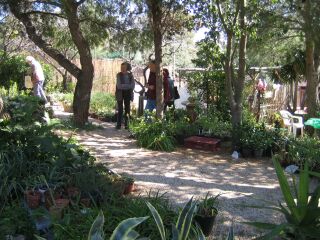
The Sparoza nursery before the Plant and Seed Exchange,
Saturday March 20, 2010.
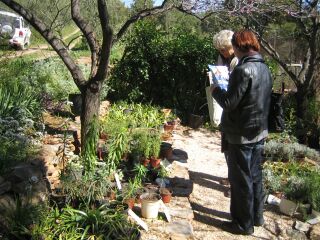
Identifying the plants.
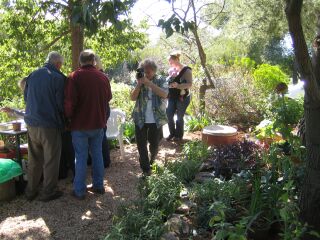
Babies and Photographers welcome.
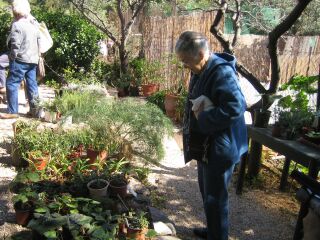
"Will this giant Ferula communis fit in my garden?"
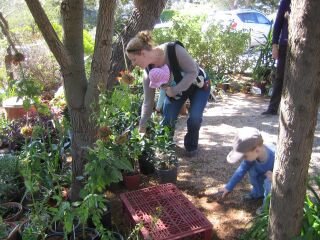
Visitors of all generations.
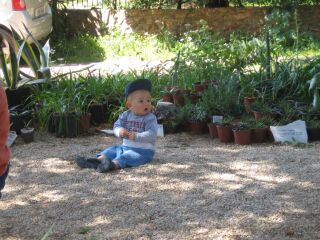
A future member of the MGS.
|


